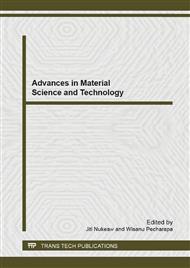[1]
C. Tang, S. VanSlyke, Organic electroluminescent diodes, Appl. Phys. Lett. 51 (1987) 913-915.
DOI: 10.1063/1.98799
Google Scholar
[2]
J.H. Burroughes, D.D.C. Bradley, A.R. Brown, R.N. Marks, K. Mackay, R.H. Friend, P.L. Burn, A.B. Holmes, Light-emitting diodes based on conjugated polymers, Nature 347 (1990) 539.
DOI: 10.1038/347539a0
Google Scholar
[3]
W. Brutting, S. Berleb, A.G. Muckl, Space-charge limited conduction with a field and temperature dependent mobility in Alq light-emitting devices, Synth. Met.122 (2001) 99.
DOI: 10.1016/s0379-6779(00)01342-4
Google Scholar
[4]
P.W.M. Blom, M.J.M. deJong, M.G. van Munster, Electric-field and temperature dependence of the hole mobility in poly(p-phenylene vinylene), Phys. Rev. B 55 (1997) R656.
DOI: 10.1103/physrevb.55.r656
Google Scholar
[5]
S. Khantham, B. Tunhoo, K. Onlaor, T. Thiwawong and J. Nukeaw, Electrical properties of dye-doped colour tunable organic light emitting diode, Can. J. Chem. Eng., 90 (2012) 903–908.
DOI: 10.1002/cjce.21658
Google Scholar
[6]
C. B. Lee, A. Uddin, C. C. Teo, Effect of polar dopant on energetic and positional disorders in tris(8-hydroxyquinolinato) aluminum (Alq3), Appl. Phys. A 83 (2006) 115-121.
DOI: 10.1007/s00339-005-3467-y
Google Scholar
[7]
G. Chauhan, R. Srivastava, P. Tyagi, A. Kumar, P.C. Srivastava, M.N. Kamalasanan, Frequency dependent electrical transport properties of 4,4',4''-tris (N-3-methylphenyl-N-phenylamine) triphenylamine by impedance spectroscopy, Syn. Met. 160 (2010) 1422–1426.
DOI: 10.1016/j.synthmet.2010.04.022
Google Scholar
[8]
S.H. Kim, K.H. Choi, H.M. Lee, D.H. Hwang, L.M. Do, H.Y. Chu, T. Zyung,Impedance spectroscopy of single- and double-layer polymer light-emitting diode, J. Appl.Phys. 87 (2000) 882.
DOI: 10.1063/1.371956
Google Scholar
[9]
M.A. Lampert, P. Mark, Current Injection in Solids, Academic Press, New York, 1970.
Google Scholar
[10]
A. A. Shoustikov, Y. You and M. E. Thompson, Electroluminescence Colour Tuning by Dye Doping in Organic Light-Emitting Diodes, IEEE J. Sel. Top. Quantum Elect.4 (1998) 3–13.
DOI: 10.1109/2944.669454
Google Scholar
[11]
A. C. Uddin, C. B. Lee, X. Hu, T. K. S. Wong and X. W. Sun, Effect of Doping on Optical and Transport Properties of Charge Carriers in Alq3, J. Cryst. Growth 288 (2006) 115–118.
DOI: 10.1016/j.jcrysgro.2005.12.034
Google Scholar


